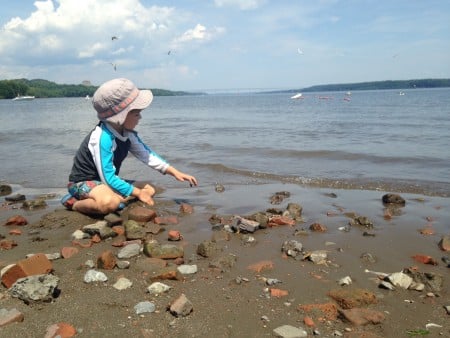A Glimpse of the Hudson’s Abundance
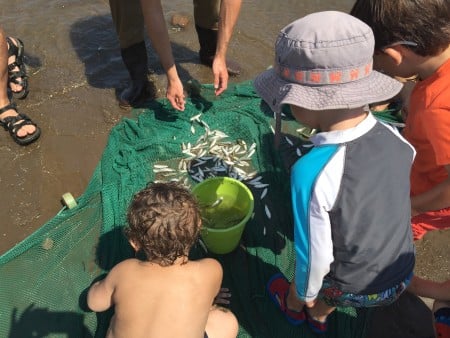
A net full of young-of-the-year striped bass and river herring. (Photo by Dan Shapley / Riverkeeper)
View more images on our Flickr site
There is no hint of them at the surface of the water, or in the warm gentle waves on our legs. But as we haul the seine net to the beach, the life that fills our muddy river is suddenly apparent: Writhing, gasping silvery fish, each no bigger than my little finger.
In two hauls at Kingston Point, maybe a half hour of effort overall, we found more than 200 young-of-year striped bass and river herring (shad, alewives and/or blueback herring: telling these species apart at this young age is beyond my expertise), along with one banded killifish.
On Saturday, August 15, the Great Hudson River Fish Count brought this kind of glimpse beneath the surface to 17 locations along more than 150 miles of river, from New York City to Waterford. The event is organized river-wide by the Department of Environmental Conservation’s Hudson River Estuary Program, and at Kingston Point with the Kingston Parks and Recreation Department. Clearwater’s indispensable Key to Hudson River Fishes made the task of identifying fishes easy for two five-year-olds on hand.
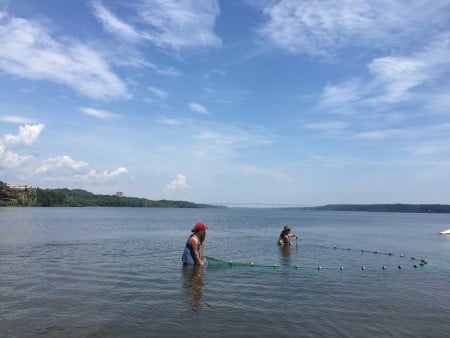
Participants in the Great Hudson River Fish Count drag a seine net at Kingston Point. (Photo by Dan Shapley / Riverkeeper)
The young people on hand — two five-year-olds, a four-year-old and my own three-year-old — were like reflections above water of what lies beneath. For many of the Hudson’s signature species like striped bass, shad, alewives, blueback herring and Atlantic sturgeon, the Hudson is a nursery. Just as we raise our kids, aiming to keep them well fed and free from harm, the Hudson provides sanctuary for these fish, which will spend their adult lives in the Atlantic Ocean.
These fish have used the estuary for 10,000 years or so, since the great mile-thick glaciers that overspread the land broke up and melted, opening the Hudson as we know it today, an arm of the sea as far north as the federal dam at Troy, and as far into each tributary as the first waterfall or dam blocks their way. (An important effort is underway to prioritize which dams might be removed to improve habitat, and there is a Sept. 2 public seminar on the topic.) In our comparatively short residency on the banks of this river, we’ve radically altered the habitat — destroying more than six square miles of prime spawning grounds in the upper third of the estuary alone, and altering at least 71 miles of shoreline. Indian Point and other power plants kill billions of fish every year when drawing cooling water from the river using antiquated technology. Toxic waste, most notably General Electric Co.’s PCBs, contaminate their flesh — and ours, when we eat them. Invasive species, like water chestnut and zebra mussels, have radically altered the ecosystem, often to the detriment of fish by competing for the same plankton they need to eat, or depleting oxygen they need to breathe. And we’ve treated the river more like a mine than a nursery, extracting as much from it as it as possible, with too little thought for how much it needs to sustain future abundance.
The abundance we’ve lost is hard to fathom. A cultural amnesia takes hold, with each generation forgetting what the last thought of as “normal,” and each generation accepting less abundance as its own new “normal.”
In the Hudson and the Atlantic, we fished wildly abundant American shad schools to almost nothing, until finally closing the fishery in 2009. Atlantic sturgeon were targeted for caviar until the fishery was closed in the mid-1990s coastwide, and they were declared endangered in 2012. River herring have enjoyed greater protections from those who catch them — mostly for bait — where they spawn in tributaries, only in the last couple years.
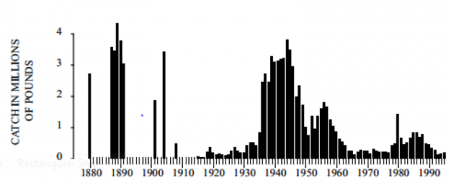
Commercial landings of American shad, by pound, in the Hudson River. Research by Hattala, 1997. Via: http://pages.vassar.edu/hudsonvalleyguidebook/articles/
We tend to think of the environmental movement as old, but when it comes to protecting the fish that spawn in the Hudson, the effort is startlingly young. Protecting these fish outside of the Hudson takes political and cooperative efforts with other states, the Atlantic States Marine Fisheries Commission and others. But in the Hudson, we have the power to preserve our nursery. There are some signs of recent good news, based on surveys of young-of-year fish reported at this year’s Hudson River Summit: Recent upticks in the numbers caught of both shad and sturgeon — from depressingly low levels, but upticks nonetheless. (The old Blues lyric comes to mind: “I’ve been down so long, it looks like up to me.”)
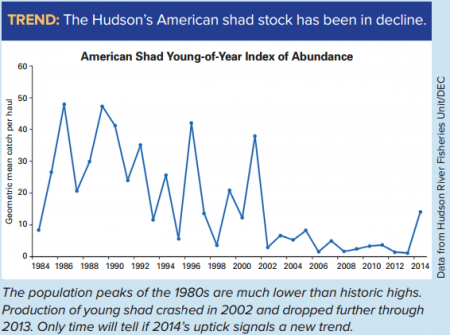
A small uptick in young-of-year shad caught in annual surveys in 2014 is a hopeful sign. (Chart from State of the Hudson 2015, http://www.dec.ny.gov/docs/remediation_hudson_pdf/hresoh15all.pdf)
If fisheries management is relatively young, habitat restoration is younger still. A budding effort to establish priorities as part of a comprehensive restoration plan, and the money to pay for projects, has been building in just the last few years.
I often think about what kind of river, and world, will be here for my son when he’s my age. Will cultural amnesia win out, leaving us with no real memory of the abundance we could enjoy? Or will the Hudson be “full of fish,” again, as Robert Juet wrote while chronicling Henry Hudson’s voyage in 1609? Will local fish be on the plate in Spring, alongside locally grown produce from our farms? Or will we have marine sanctuaries established, providing protection for fish here, to do our part to protect the abundance of the oceans?
Picking tiny young-of-year fish from the seine net, aiming to be both quick and gentle, one can’t help but wonder.

